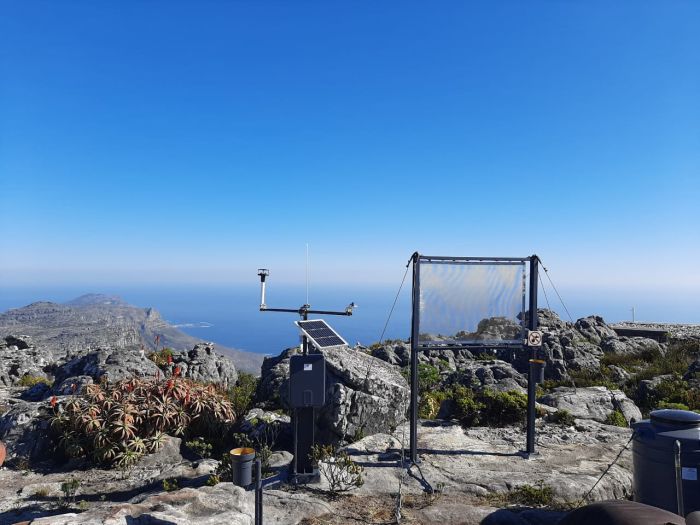


南アフリカ南西部では、2015年から2017年まで3年連続で乾燥した冬が続き、2018年初頭にはケープタウンで「デイゼロ」干ばつが発生しました。ケープタウンの水危機は、シャツを洗う回数を誰が一番少なくできるかを競うコンテストが行われるほどに悪化しました。レストランや企業でさえ、客や従業員に排水を減らすよう呼びかけました。この時点で、同市は水道を止めるまであと90日というところでした。
1年後、南アフリカのこの都市の干上がったダムは80%以上が満水になりました。水使用制限は緩和され、ケープタウンの市営水道が停止される「デイ・ゼロ」は到来しませんでした。この危機の回避に関する詳細は、この世界経済フォーラムの記事で確認できます。
乾燥した冬に必要となったケープタウン市は、霧の採取によってこの地域の主な水源を補う可能性を測るプロジェクトをテーブルマウンテンで立ち上げました。まだ初期段階ではありますが、このプログラムの考案者は、山に複数の霧捕集装置を建設することの実現可能性を判断したいと考えています。実現可能性調査と研究段階は、2022年12月までに完了する予定です。
このケース スタディの公開日現在、テーブル マウンテンには、基本的な気象パラメータと収集された霧を測定するための 2 つの Campbell Scientific 気象ステーションが設置されています。両方の気象ステーションには、霧から水を捕らえる、つまり「収穫」するために特別に設計された 1.5 m² (16.2 ft²) のスクリーンが装備されています。
ケープタウン市は、スクリーンに使用できるさまざまな素材のオプションをテストしています。1 つのスクリーンは 40% シェード クロスで作られ、もう 1 つは 316 ステンレス鋼を使用しています。霧がスクリーンの表面で凝縮すると、水分が表面に蓄積され、下の溝に集まります。水滴は転倒マス式雨量計に送られます。1 滴は 0.649 mL (0.022 オンス) の水に相当します。
ケープタウンには主に 2 つの風向があります。冬は北西風が冷たい大西洋から雨を運び、夏は南東風がインド洋から吹き、テーブル マウンテンにかかっているように見える雲を形成します。プログラムの作成者は、この気象現象によって収穫のための霧がたくさん発生することを期待しています。「調査と理解が深まるほど、私たちはより強くなり、よりよく備えることができます」と、ザンシア リンバーグ議員 (水と廃棄物に関する市長委員会委員) は述べています。
テーブル マウンテンの水分密度に関する最初の公式調査は、1 世紀以上前にドイツ生まれの植物学者ルドルフ マルロスによって実施されました。それ以降に実施された調査では、年間の霧の降水量が約 3,294 mm (129.7 インチ) と測定されました。これはケープ タウンで記録された年間平均降水量の 3 倍に相当します。この山の有名な「テーブルクロス」 (科学的には山岳性雲の形成と呼ばれます) は、高地の水分と霧採取プログラムを取り巻く楽観主義の多くに関係しています。
キャンベル・サイエンティフィックの気象観測所のデータを確認すると、霧の採取の可能性を生み出す一連の出来事に注目すると興味深いことがわかります。
- 夏の乾季には、風は通常午後に強くなり、南から南東に向かって吹きます。
- 風が強まると、テーブルマウンテンの気温は大幅に下がり、相対湿度は急激に増加します。
- 相対湿度が 100% に達すると、太陽放射照度は 1,000 W/m² から 100 W/m² 未満に低下します。
- 数分後、「霧計」に最初の雨量が記録されますが、雨量計には降水量は記録されません。これは、雨水ではなく霧が集まっていることを示しています。
ケーススタディの概要
アプリケーション
水分収集のための霧の測定場所
ケープタウン、南アフリカ使用製品
HMP50-ET CS320 HygroVue 5 CS106 CR800 TE525WS-L寄稿者
Campbell Scientific Africa (CSAF)参加団体
南アフリカ水・廃棄物委員会計測項目
湿度、降水量関連ウェブサイト
Business Insider Article about Table MountainPDFで見る